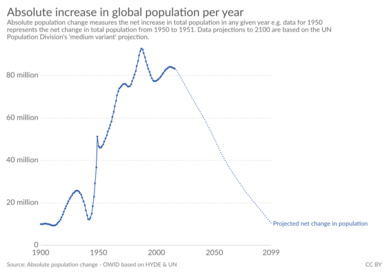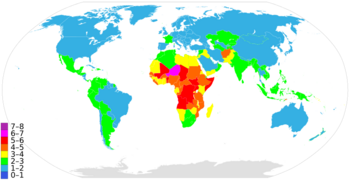Population growth facts for kids
Population growth means an increase in the number of people living in a certain area or across the whole world. Right now, the global human population grows by about 83 million people every year. That's like adding a new country the size of Germany each year!
The world's population has grown a lot. In 1800, there were 1 billion people. By 2020, there were 7.9 billion. Experts at the United Nations (UN) think the population will keep growing. They estimate it could reach 8.6 billion by 2030, 9.8 billion by 2050, and 11.2 billion by 2100. However, some other experts believe the population might stop growing and even start to shrink before 2100.
The world's population has been growing steadily since the Black Death plague ended around 1350. This growth happened because of new technologies that helped us grow more food. Also, better hygiene and new medicines meant fewer people died from diseases. In many rich countries, population growth has slowed down. This is part of something called the demographic transition. But in less developed countries, the population is still growing quickly. The fastest rate of global population growth was in 1963, at 2.2% per year. Since then, it has slowed down.
When the population grows, and people use more resources, it can cause environmental problems. These include things like biodiversity loss (losing different kinds of plants and animals) and climate change. This happens because we use too many natural resources for human activities. International efforts, like the Sustainable Development Goals, aim to improve how people live around the world while also protecting our planet.
| Years passed |
Year | Pop. (billions) |
|---|---|---|
| – | 1800 | 1 |
| 127 | 1927 | 2 |
| 33 | 1960 | 3 |
| 14 | 1974 | 4 |
| 13 | 1987 | 5 |
| 12 | 1999 | 6 |
| 12 | 2011 | 7 |
| 11 | 2022 | 8 |
| 14 | 2037* | 9 |
| 18 | 2055* | 10 |
| 33 | 2088* | 11 |
| *Based on UN estimates from 2017 | ||
Contents
History of Population Growth
The world's population has been increasing steadily since the Black Death ended around 1350. During the Industrial Revolution in Western countries, the population started to grow very quickly. The biggest jump in world population happened after the 1950s. This was mainly due to amazing medical discoveries and better ways to grow food, which meant more people survived and lived longer.
How Fast is Population Growing?
The speed at which the world's population grows reached its highest point in 1963, at 2.2% per year. Since then, it has slowed down. In 2017, the growth rate was about 1.1% per year. This means that for every 100 people, about 1.1 more people are added each year.
Over the last 100 years, the world's population has grown four times larger! This huge increase is thanks to medical advances, lower death rates, and new farming methods like the Green Revolution that helped produce much more food.
The actual number of new people added to the world each year was highest in 1989, with 88 million new humans. It then went down for a while but rose again to 83 million in 2017. In many developed countries, population growth has slowed down. However, in some parts of the Middle East, Sub-Saharan Africa, South Asia, Southeast Asia, and Latin America, the population is still growing very fast, sometimes more than 2% per year.
In some countries, the population is actually getting smaller. This is happening in parts of Eastern Europe, mostly because women are having fewer children, more people are dying, and many people are moving away. In Southern Africa, growth is slowing down partly due to many deaths related to illnesses. Japan's population started to decrease in 2005.
The United Nations expects the world population to reach 11.2 billion by the end of this century. However, other research groups have different ideas. For example, one group predicts the global population will reach 9.73 billion in 2064 and then drop to 8.89 billion by 2100. Another study suggests it will reach 11 billion by 2100 and might keep growing into the next century.
Population Growth Around the World
Between 1990 and 2010, the world population grew by 1.6 billion people. That's a 30% increase! The biggest increases in terms of numbers of people were in India (350 million more people) and China (196 million more people). Countries like the United Arab Emirates and Qatar saw some of the fastest growth rates.
Many countries, especially in Sub-Saharan Africa, the Middle East, and parts of Asia, have seen a very sharp rise in their populations since the end of the Cold War. Some people worry that these high population numbers put a lot of pressure on natural resources, food, fuel, jobs, and housing in these countries. For example, the population of Chad grew from about 6.3 million in 1993 to over 10.3 million in 2009, which puts a strain on its resources. Countries like Vietnam, Mexico, Nigeria, Egypt, Ethiopia, and the DRC are experiencing similar fast growth.
| Population Growth 1990–2012 (%) | |
|---|---|
| Africa | 73.3% |
| Middle East | 68.2% |
| Asia (excluding China) | 42.8% |
| China | 19.0% |
| Developed Americas | 27.9% |
| Developing Americas | 36.6% |
| Developed Europe | 11.5% |
| Developed Asia and Oceania | 11.1% |
| Developing Europe and Eurasia | -0.8% |
Future Population Trends
Experts use different models to predict how the world's population will change in the future. These predictions help countries plan for things like food, housing, and resources. While some models suggest the population will keep growing for a long time, others predict it might start to decline later this century.
Images for kids
-
Estimates of population evolution in different continents between 1950 and 2050 according to the United Nations. The vertical axis is logarithmic and is in millions of people. (2011)
-
Bangladesh is one of the most densely populated countries in the world. The capital, Dhaka, bustles around Nilkhet Mor.
-
Estimated size of human population from 10,000 BCE to 2000 CE
See also
 In Spanish: Crecimiento poblacional para niños
In Spanish: Crecimiento poblacional para niños
- List of countries by population growth rate
- Demographic history
- Demographic transition
- Density dependence
- Ecological overshoot
- Epidemiological transition
- Human population planning
- Irruptive growth
- Overshoot (population)
- Population decline
- Population density
- World population
- Estimates of historical world population
- Zero population growth








